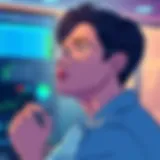The Evolution of Comic Strips in Modern Media


Intro
Comic strips have traversed an intriguing path from their humble beginnings in print media to the vibrant digital platforms we encounter today. Their capacity to blend narrative and illustration offers a unique form of storytelling that has captivated audiences for generations. Today, comic strips play a pivotal role in modern media, serving as a reflection of cultural sentiment while showcasing innovative artistic styles and narrative structures.
Technology Insights
The evolution of comic strips is deeply intertwined with advancing technology. As we explore the current landscape, it is essential to analyze how technology influences both the production and distribution of comic strips.
Latest Tech Trends
Digital tools are changing the way comic artists create. Software such as Adobe Photoshop or Clip Studio Paint allows artists to explore visual creativity more freely. Webcomics have gained grounds because they can be shared over the internet easily, reaching wider audiences instantly.
- Accessibility: Artists can share their work with global audiences without traditional middlemen.
- Interactivity: Comics can now include multimedia elements and hyperlinks, enhancing reader engagement.
Innovation in Tech
Platforms like WEBTOON and Tapas have redefined how comic strips are distributed. They have introduced formats that cater to mobile reading, tapping into the ever-growing preference for content consumed on smartphones. The scrolling format of comics allows for a different pacing, making the narrative flow seamlessly.
Additionally, artists are utilizing augmented and virtual reality to create immersive experiences. Readers can engage with comic strips in ways that were previously unimaginable. This tech-driven transformation is setting the stage for the future of the medium.
Product Reviews
Various tools have emerged that assist comic artists in their craft.
- iPad Pro: A popular choice for digital illustration, enabling artists to draw directly. The Apple Pencil provides precision that many find essential.
- Wacom Cintiq: Highly regarded for its sensitivity, it offers a pen-on-screen experience suitable for meticulous work.
Both products bridge traditional drawing practices with digital innovation, marking a significant advancement in comic creation.
"As comics embrace digital innovation, their potential for sophistication and depth expands significantly."
Entertainment Highlights
Comic strips not only serve as standalone narratives but also have influenced the entertainment sector. They lay the groundwork for various adaptations in movies and series.
- Cross-media: Notable comic strips like "The Walking Dead" and "Watchmen" have seamlessly transitioned from paper to screen, capturing the essence of their stories while reaching larger audiences.
- Cultural references: Comic strips often mirror societal issues, effectively making statements that resonate beyond their frames.
Design Showcase
Artistry in comic strips presents a scope that is both broad and specialized. The designs are not merely supportive of the narrative; they are integral to storytelling.
- Diverse artistic styles: From minimalist to hyper-detailed works, comic strips showcase a wide array of design approaches.
- Graphical innovation: The interplay of colors, paneling, and typography reflects the creativity of artists and their evolving styles.
Industry Spotlights
As the landscape of comics continues to evolve, professionals are shaping this evolution. Insights from industry experts can provide valuable perspectives.
- Interviews with comic artists: Learning about their experiences can shed light on prevailing trends and innovations.
- Spotlight on editors and publishers: Understanding their challenges can clarify the dynamics between artists and the market.
Event Coverage
Comic festivals and conventions often act as a crucible for new talent and ideas. Coverage of these events can highlight important developments in the comic strip medium.
- Conventions: Events like Comic-Con offer platforms for artists to showcase work and connect with fans.
- Awards: Celebrating excellence in the field, awards such as the Eisner Awards create benchmarks for quality and innovation within the industry.
Prologue to Comic Strips
Comic strips hold a significant place in the realm of visual storytelling. They present an engaging form through which both humor and serious themes can be conveyed. The unique combination of images and text allows for a distinctive narrative structure that captures readers’ attention in just a few panels. Understanding comic strips is crucial, especially as we delve into their evolution and impact on modern media.
Definition and Characteristics of Comic Strips
Comic strips are typically short sequences of drawings arranged in panels that tell a story or convey an idea, often featuring speech or thought bubbles. They can be both humorous and serious, with a variety of genres ranging from soap operas to satire. Key characteristics include concise storytelling, visual immediacy, and a reliance on juxtaposition to build meaning. Comic strips have a straightforward format, making them accessible while still maintaining depth in their narrative.


Historical Context of Comic Strips
Comic strips have a rich history that begins in print media. They evolved greatly over time, reflecting societal changes and advancing in artistic techniques.
Origins in Print Media
The origins of comic strips can be traced back to the late 19th century when they first appeared in newspapers. Pioneering artists like Richard Outcault created strips such as "Hogan's Alley," featuring the iconic character, the Yellow Kid. This innovative choice of combining illustrations with narratives engaged readers and set the groundwork for future comic strips. The unique feature of comic strips during this period was their ability to reach a broad audience, making serious topics accessible through humor or daily life situations.
The advantage of this format is its ability to illustrate complex ideas simply and effectively, while the disadvantage could be the limitation of themes due to restrictions imposed by publishing platforms.
Development in the 20th Century
The development in the 20th century saw comic strips flourish and diversify. Iconic characters like Charlie Brown from "Peanuts" by Charles Schulz and the adventures of Tintin by Hergé became cultural staples. By this time, comic strips had solidified their presence not just in newspapers but also in comic books and other media. Their key characteristic was the blend of art and storytelling that could entertain and provoke thought simultaneously.
During this era, comic strips gained immense popularity. Through innovative storytelling, artists explored various genres that resonated with a wider audience, focusing on themes such as romance, social issues, and adventure. This diversity was a valuable aspect of developing comic strips, allowing for greater expression and connection to societal contexts.
Despite its popularity, the challenges of sustaining reader interest amidst the growing entertainment landscape remained a consideration for creators.
The Art of Comic Strip Creation
Comic strips represent a unique blend of art and narrative. This section delves into the fundamental aspects of comic strip creation, highlighting its significance in the landscape of visual storytelling. The ability to weave stories through a combination of images and text provides unparalleled means for creators to engage audiences. As readers, we often encounter a myriad of themes and genres, but behind every successful comic strip lies a thoughtful artistic process.
Elements of Visual Storytelling
Visual storytelling in comic strips relies on several key elements, including character development, plot progression, and emotional resonance. Each element works in concert to build a narrative that is both compelling and relatable. Characters serve as the central figures driving the story forward. Their design and evolution throughout the strip can significantly impact reader connection.
Plot serves as the framework, presenting conflict and resolution in a structured manner. The emotional tone often dictates the color palette and panel technique. By pushing the boundaries of visual representation, creators can evoke feelings that go beyond simple dialogue, creating layered storytelling that resonates with a diverse audience.
Techniques in Comic Strip Art
Comic strip art combines various techniques that contribute to the overall aesthetic and narrative structure. These can be categorized into three main areas: panel composition, character design, and use of color.
Panel Composition
Panel composition refers to the arrangement of panels within a comic strip. This aspect is crucial as it dictates the flow of the narrative. An effective panel layout guides the reader’s eye and influences pacing. The key characteristic of panel composition is its ability to create rhythm in storytelling. For instance, larger panels often emphasize dramatic moments, while smaller ones can generate quick simplicity.
A popular choice for comic strip creators is the use of grid layouts, which offer clarity and structure. However, breaking from traditional formats can enhance storytelling by introducing surprise or tension. The unique feature of panel composition lies in its flexibility to evoke various responses. While the advantages include varied pacing and reader engagement, challenges can arise if the layout becomes too complex or contradictory to narrative flow.
Character Design
Character design is another vital aspect of comic strip creation. It embodies the visual identity of a character, influencing how readers perceive them. The key characteristic in character design is recognizability. Well-designed characters often have unique attributes that resonate with readers, making them memorable.
For comic strips, a simplified design style is often beneficial, allowing for quicker recognition and stronger emotional connections. One unique feature common in character design of comic strips is exaggeration; this can manifest through facial features or body proportions to reflect personality traits. While this style of design enhances reader understanding of characters, it can have limitations in portraying complex narratives if nuances are overlooked.
Use of Color
The use of color adds another layer to visual storytelling in comic strips. Color can set the mood, delineate characters, and symbolize themes. A fundamental characteristic of using color is its emotional impact. Warm colors may convey happiness or excitement, while cooler tones might evoke sadness or calmness.
Color choices greatly benefit the overall aesthetic of comic strips. For instance, monochromatic schemes can create a specific atmosphere or bridge different story elements. One unique feature of color usage is how it can direct reader focus within a panel, highlight certain actions, or foreshadow events. However, challenges can arise with too much color, which may create visual pollution. Balancing color is thus essential for retaining clarity while enhancing storytelling.
"The art of comic strip creation lies in the balance between visual elements and narrative depth, allowing for resonant storytelling in compact formats."
In summary, the art of comic strip creation encompasses multiple techniques and considerations that are essential for effective storytelling. By mastering elements such as panel composition, character design, and the use of color, creators can craft narratives that engage and resonate with readers through both print and digital media.
Genres and Themes in Comic Strips
The genres and themes present in comic strips play a vital role in engaging readers and shaping cultural dialogue. They serve as vehicles for expression and creativity, allowing authors to explore various facets of human existence and societal issues. Through humor, adventure, fantasy, and social commentary, comic strips resonate with diverse audiences, contributing to their enduring relevance in modern media.
Humor and Satire
Humor is perhaps the most recognizable theme in comic strips. It provides not just entertainment, but also a lens through which readers can laugh at their own experiences and those of others. Classic examples include strips like Peanuts and The Far Side, which utilize wit and absurdity to comment on everyday life.


Satirical comic strips, such as Doonesbury, push this further by addressing political and social commentary through humor. This approach can provoke thought, challenge norms, and inspire change, illustrating how humor can transcend mere entertainment to become a form of activism. The ability to encapsulate complex ideas in a few frames makes humor a powerful tool for engagement and reflection.
Adventure and Fantasy
The adventure and fantasy themes in comic strips open doors to worlds beyond reality, inviting readers to escape into imaginative realms. Series like Calvin and Hobbes and The Adventures of Tintin exemplify how these genres captivate the audience through character-driven narratives and plots filled with excitement.
These strips often blend humor with adventure, creating an alluring mix that appeals to readers of all ages. They encourage exploration and creativity, letting readers envision situations that stretch the boundaries of reality. The escapism offered by adventure and fantasy comic strips remains a significant pull factor in today’s media landscape.
Social Commentary and Politics
Comic strips also frequently serve as a medium for social commentary and political critique. This genre reflects societal struggles, injustices, and triumphs. For instance, Doonesbury critiques political events and cultural shifts, often becoming a vital part of public discourse. In this way, comic strips contribute to shaping public perception and influence the dialogue around pressing issues.
By presenting these themes in a concise format, authors can express complex thoughts and challenge readers to consider multiple perspectives. This thematic depth underscores the significant role of comic strips in engaging with contemporary social issues and the evolution of political thought.
"Comic strips have the unique ability to communicate profound thoughts in a simple and engaging manner, presenting issues that matter while still entertaining."
The Transition to Digital Platforms
The transition of comic strips to digital platforms marks a pivotal shift in their distribution, accessibility, and engagement. As consumption of media changes with society’s reliance on the internet, comic strips have evolved to meet the demands of a digitally savvy audience. This transition is not just about format; it is about redefining how stories are told and consumed.
Impact of the Internet on Comic Strip Distribution
The rise of the internet has transformed how comic strips reach their audiences. Traditional print distributions are limited by geographical constraints and publication schedules. However, the internet breaks these barriers. Readers can access a myriad of comic strips from around the world at any time. This immediacy has increased the overall reach of comic strip creators.
Many artists now publish their work online through personal websites, social media platforms, and dedicated comic hosting sites like Webtoon and Tapas. These platforms allow for direct interaction between creators and fans. Readers can provide feedback instantly, creating a sense of community that enhances the experience.
Furthermore, some authors tailor their content to align with trending topics, allowing them to engage with timely issues and maintaining relevance in popular culture. This not only helps in gathering a steady following but also attracts new readers who discover strips through social sharing.
Emergence of Webcomics
Webcomics represent a genre that has arisen from this transition to digital. Unlike traditional comic strips that were confined to newspapers or magazines, webcomics allow for more experimental formats and storytelling techniques. Artists can integrate multimedia elements, such as animations and interactive features, fostering a dynamic reading experience.
The production cycle has also accelerated. Independent creators can publish new content frequently without waiting for traditional publishing schedules. This agility keeps stories fresh and engaging, sometimes adapting to reader feedback in real-time.
Another crucial aspect is the diversification of voices within the medium. Webcomics have provided a platform for underrepresented creators, allowing them to share stories and perspectives that might not have found traditional publishing opportunities. This broadens the scope and richness of the comic strip landscape, appealing to a wider audience.
The transition to digital has not only revolutionized the distribution of comic strips but has also democratized the medium, making it accessible to a diverse range of artists and readers.
Cultural Impact of Comic Strips
Comic strips serve as more than mere entertainment; they have a profound influence on cultural perceptions and societal trends. As a visual storytelling medium, comic strips encapsulate complex themes in simplified formats, making them accessible to a broad audience. This accessibility contributes significantly to their lasting impact in modern media.
These strips often reflect and shape cultural values and assumptions. The humor or narrative styles resonate with readers, creating a shared understanding among diverse populations. By addressing contemporary issues, comic strips hold a mirror to society, prompting conversations around topics that may otherwise go unexamined. Moreover, their use of humor and satire can often defuse tensions surrounding sensitive topics, making critical commentary palatable.
In the digital age, the reach of comic strips has only expanded. Platforms such as social media allow for rapid dissemination of illustrations and narratives that capture the zeitgeist of a generation. As a result, comic strips can influence fashion trends, political movements, and online discourse, illustrating their power as cultural artifacts.
Influence on Pop Culture
Comic strips hold an indispensable place within pop culture. Characters born in comic strips often evolve into beloved icons, bridging gaps across various forms of media including movies, television shows, and video games. For instance, characters like Snoopy from Peanuts or Spider-Man from Marvel have transcended their original formats, becoming integral parts of global cultural identities.
Several trends and phenomena in pop culture directly trace their roots to comic strips:
- Merchandising: Characters and stories become brand ambassadors, leading to extensive merchandise lines.
- Cross-Media Adaptations: Storylines transition to other media, enriching the narratives and expanding audiences.
- Cultural References: Comic strips embed themselves into everyday language and expressions, becoming a reference point in popular discussions.
The impact of comic strips in pop culture is not static. They adapt continuously, evolving with societal changes while influencing the entertainment landscape.
Role in Social Movements
Comic strips have historically been powerful instruments for social change. They can raise awareness, provoke thought, and mobilize support for various movements. Through satire and critical narrative, comic strips shine a light on injustice, often in ways that traditional media cannot. They can address issues such as inequality, discrimination, and environmental crises, engaging audiences in the process.
Moreover, comic strips provide a voice for marginalized communities. By representing diverse experiences and perspectives, they contribute to the broader dialogue around social justice issues. They are often more relatable for younger audiences, facilitating discussions around topics like mental health, race relations, and gender equality.


Notably, many campaigns have utilized comic strips for advocacy. For instance, organizations often share illustrated messages on social media to promote awareness and understanding, demonstrating the potential of comics as a tool for activism.
"The world of comic strips showcases a unique intersection of art and activism, amplifying voices that often go unheard."
Associating comic strips with such social movements enhances their relevance. They turn comic artistry into a powerful force that can inspire change and galvanize community support.
Challenges Facing Comic Strips Today
Comic strips have a rich history and an impactful presence in modern media; however, they also face several challenges in today’s evolving landscape. The rise of digital platforms has reshaped how comics are created, shared, and consumed. Therefore, understanding the hurdles in this medium is critical for sustaining its relevance in contemporary society.
Monetization Issues
One notable challenge is related to monetization. The shift to online distribution has complicated revenue-generating models that traditionally relied on print sales and advertising. Many artists and writers find themselves struggling to translate their creative work into sustainable income. The landscape is crowded, with numerous platforms vying for attention, which makes it essential for creators to establish a viable financial strategy.
- Subscription models have gained popularity, but they require a loyal reader base, which can be difficult to achieve.
- Crowdfunding through platforms like Patreon allows for some artists to receive support directly from fans, yet it may not provide enough for everyone.
- Ad revenue is often unpredictable and dependent on web traffic.
The need for innovation in monetization strategies is essential. This situation prompts creators to explore partnerships and alternative revenue streams. Without effective solutions, some may struggle to continue producing their art.
Maintaining Reader Engagement
Another critical dimension is maintaining reader engagement. In a world flooded with content, comic strips must find ways to captivate their audience continually. The immediacy of social media adds pressure to produce frequently, but this can dilute quality.
- Interactive content can enhance connection, drawing readers into stories more effectively.
- Engagement metrics on various platforms can help creators understand what resonates with their audience. This insight is vital for tailoring content.
- Community building through social media platforms fosters a loyal base that interacts with creators directly.
"The future of comic strips will depend significantly on their ability to adapt to changes in audience engagement and consumption patterns."
Successful comic strips must balance quality storytelling with strategies that keep readers coming back. Creators are realizing that engaging directly with fans and developing personal connections can provide significant advantages. As the landscape continues to evolve, these challenges will not only test the resilience of comic strip creators but also shape their future directions.
The Future of Comic Strips
The landscape of comic strips is constantly evolving. As more readers turn to online platforms for their content, the future of comic strips holds much potential. The integration of technology into comics not only shifts how they are created and consumed but also defines new storytelling possibilities. Factors such as augmented reality and interactive storytelling are at the forefront of this transformation, offering immersive experiences that traditional formats cannot achieve. In addition, as diverse voices gain visibility, the narrative fabric of comic strips is enriched, reflecting a broader spectrum of cultural experiences.
Innovations in Technology
Augmented Reality in Comics
Augmented reality (AR) creates an enhanced experience by overlaying digital elements onto the physical world. This technology can transform a static comic strip into a dynamic narrative. When readers point their devices at a comic, they may see animations, hear sound effects, or access additional content. Key characteristics include interactivity and engagement, making AR a compelling choice for creators looking to innovate.
One unique feature of augmented reality is its ability to engage the audience on multiple sensory levels. Readers might first identify with the characters and then experience them in a more vivid way through interactive animations. This aspect can lead to deeper emotional connections with the story and its themes. However, challenges exist, such as the need for devices capable of supporting AR experiences and the potential for distracting users from the core narrative. Despite the challenges, the use of AR in comics illustrates the potential for redefining how stories can be told.
Interactive Storytelling
Interactive storytelling allows readers to influence the storyline through choices they make along the way. This form of storytelling fosters a sense of agency in the reader, encouraging them to become active participants in the narrative. Key characteristics include branching story paths and user-driven decisions, which can significantly enhance reader engagement.
One unique aspect of interactive storytelling is its ability to cater to diverse reading preferences. Audience members can explore the narrative in a manner that suits their interests, promoting varied outcomes. However, this approach demands significant creative effort from authors to develop multiple storylines and ensure consistency and coherence. Ultimately, the balance of complexity and creativity in interactive storytelling presents a valuable opportunity for comic strips, expanding upon traditional linear narratives.
Growing Popularity of Diverse Voices
The emergence of diverse voices in the comic strip medium reflects broader social changes. As more artists and writers from various backgrounds share their experiences, comic strips become a platform for underrepresented narratives. This growing diversity enriches the storytelling landscape and challenges traditional norms within the genre.
Readers increasingly seek stories that resonate with their identities and experiences. The influx of perspectives from various cultural contexts not only revitalizes existing themes but also creates new ones. This shift encourages inclusivity in creativity and representation, ultimately drawing a wider, more engaged audience.
Ending
Comic strips have carved out a niche in the landscape of modern media that is both unique and impactful. The importance of this art form lies in its ability to convey complex narratives through a combination of visuals and text. Comic strips not only entertain but also engage readers on critical social issues. The intersection of art and storytelling in comic strips allows for a rich exploration of themes, from humor to social commentary.
Reflection on the Importance of Comic Strips
Comic strips exude significance in various aspects of media and culture. They serve as a bridge between visual art and literature, making storytelling accessible to a wider audience. For instance, the ability to communicate messages succinctly through images and few words can often resonate more deeply than traditional narratives. This duality frees creators to explore diverse themes and perspectives without the constraints often found in longer formats.
Additionally, comic strips can influence societal norms and spark conversations about pressing issues. They have a unique capacity to reflect and critique society, evident in works that tackle political satire or social justice. This aspect establishes comic strips not only as a medium of entertainment but also as a tool for education and advocacy. Their role in shaping public opinion can be profound, as they often reach audiences who may not engage with other forms of journalism or literature.
Final Thoughts on Their Evolution
The evolution of comic strips is a testament to their resilience and adaptability. From their print origins to their digital transformation, comic strips have continuously shifted to meet the dynamics of society. The rise of webcomics exemplifies this adaptability, allowing creators to reach global audiences directly and gain immediate feedback.
Looking ahead, the future of comic strips will likely be influenced by technological innovations. With advancements such as augmented reality and interactive storytelling, comic strips may offer experiences that transcend traditional boundaries. Creators are now able to experiment with formats that encourage deeper reader interaction, further enhancing the narrative experience.
In summary, the importance of comic strips in modern media cannot be overstated. They reflect societal changes, engage with diverse audiences, and continue to evolve alongside technological advancements. As this medium moves forward, it guarantees its place as a significant player in the realm of visual storytelling.







